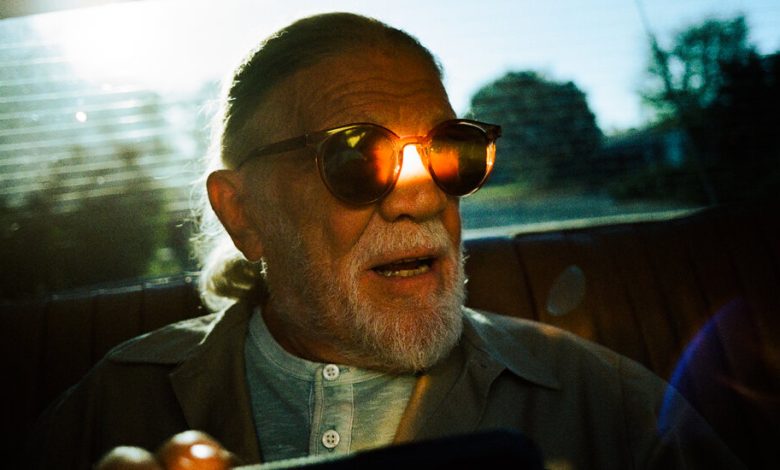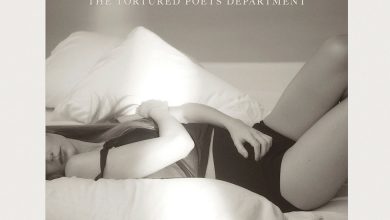He Won’t Stop Taking Pictures Until He’s Partying on the Other Side

Henry Diltz may not be the only person who can say he was at both West Point and Woodstock, but he’s the only one who has also taken pictures of Neil Young playing with nocturnal primates.
One Friday afternoon in August, after more than eight decades of wild and improbable life, Diltz was on the phone in his kitchen in North Hollywood, Calif., making arrangements to shoot some musician friends: the ’70s soft-rockers America, who were playing the following night.
Diltz was not the first of the great rock ’n’ roll photographers. Ask him and he’ll name professional forebears like Jim Marshall, who also made defining images of the rock era — Hendrix letting a chord ring, Dylan kicking a tire, Johnny Cash flipping the bird.
But since Marshall died in 2010, the 85-year-old Diltz — who first picked up a camera 57 years ago — may be the earliest of the great rock photographers still living. He is certainly the oldest one still working.

Diltz at home in California. Before he switched to a digital camera in 2005, he only shot slides.Credit…Sinna Nasseri for The New York Times
Diltz is compactly built, with a gray ponytail, a ringer in old age for the actor Seymour Cassel, a John Cassavetes mainstay. He falls asleep at night listening to George Noory on “Coast to Coast AM” rapping with the paranoid faithful about lucid dreams, conspiracies, immortality. In the morning he does a series of chakra-awakening exercises and takes a few moments to say hello, in his head, to some of the people he’s known who’ve gone to the other side.
He’s survived many of his most famous subjects, some of whom he considered his best friends, like Dan Fogelberg, and David Cassidy, whom he met on the set of “The Partridge Family” and toured with for years. Diltz has survived Cass Elliot, a couple of Eagles, all but one of the Monkees. His wife, Elizabeth Joy Grand, died in 2001. A girlfriend of nearly 20 years passed away not long ago.
They’re the lucky ones, in Diltz’s view. The other day someone called and told him the news about Robbie Robertson. Good, Diltz said — he made it out. “The party’s on the other side,” he likes to say. It’s the rest of us, stuck over here, who have it rough.
Another old friend, David Crosby, died in January. He can be seen — alive and singing and goofing around, sometimes while dressed like a cowboy or Horatio Hornblower — on page after page of Diltz’s new book “CSN&Y: Love the One You’re With,” which collects the best of the countless pictures Diltz took of Crosby and his bandmates between the late ’60s and the present day.
The book is a visual history of one band, a document of the ’60s and their long aftermath, and a record of Diltz’s own years of service at the front lines of the counterculture, which began in the early ’60s, at the military academy.
He’d never planned on West Point, but as the son of a deceased veteran, he could attend without a congressional nomination. He didn’t hate it there; he liked the pomp, the ritual. “But I belonged to the Columbia Record Club,” he said, “and I was listening to Pete Seeger.”
After a year he got out and bought a banjo. By 1966 he was a touring folkie. One morning after a college gig in Lansing, Mich., he and his band, the Modern Folk Quartet, tumbled out of their motor home and into a secondhand store.
Diltz’s bandmate Cyrus Faryar bought a cheap Japanese camera. To this day Diltz is not quite sure why he did the same. Sometimes he wonders how his life would have turned out if he’d gone to the kitchen department for a coffee mug instead.
At the next drugstore, Faryar came out with Kodak film in yellow boxes, showed Diltz the instructions on the back, how to set the shutter speed.
“It said ‘Sunlight: 250 at 8,’” Diltz said. “And that was my photo school, that Kodak box.”
Back home in Los Angeles, Diltz got his first rolls of film developed, and realized he’d been shooting slides. He and the band invited all their L.A. friends over and loaded a carousel.
“That first slide hit the wall — it was our bass player, blowing up his cardboard bass case, in the desert, with M-80s,” Diltz said.
“That’s what hooked me,” he continued. “That’s when I became a photographer. That first slide hitting the wall, eight feet wide, glowing in the dark — and my stoned hippie friends going, ‘Whoa.’”
-
Crosby, Stills & Nash (from left, though: Nash, Stills and Crosby)1969
Henry Diltz
-
Stephen Stills and Mick Jagger1970
Henry Diltz
-
Jimi Hendrix1969
Henry Diltz
-
Joni Mitchell and Graham Nash1969
Henry Diltz
-
Joe CockerWoodstock, 1969
Henry Diltz
-
Tina Turner1985
Henry Diltz
-
Neil Young1975
Henry Diltz
-
America1973
Henry Diltz
-
Jerry Garcia1971
Henry Diltz
-
Cass Elliot1968
Henry Diltz
Diltz would finally switch to digital cameras around 2005; before that, unless some band or label wanted a black-and-white photo for an 8-by-10, slides were all he shot. At his house the archive — about half of Diltz’s nondigital output — takes up one whole wall of the living room, latched plastic slide boxes stacked on wooden shelves, marked with printed labels or hand-lettered masking tape, and roughly alphabetized: “ELVIS COSTELLO” and “PHIL COLLINS” are neighbors; “ELO,” “ELP” and “EWF” share the same box.
He never imagined making a career of it. The ’60s bloomed around him and he brought his camera. People looked at him and saw a fellow musician taking pictures. Drugs helped — they were a secret handshake, a shortcut to trust. (Years later, Diltz looked at a wall of his photos, asked himself which of the subjects he’d smoked grass with, and realized it was “every single one, except Donny Osmond and Michael Jackson.”)
The archive is the product of nearly six decades of hanging out: at concerts in the wings or the pit, at Laurel Canyon hippie-pad parties, in backstage green rooms, in recording studios, where he’d time the click of his shutter to the kick drum, so the band wouldn’t notice it and throw him out for blowing the vibe.
He was a psychology major. “I was curious about people,” Diltz said. “When I picked up a camera it was like, ‘Oh, OK — now I can watch people.’”
The stealth his approach required came naturally to him. He thinks maybe it’s because his Chinese zodiac sign is the tiger. Someone once told him people born in the year of the tiger are sociable, but also loners. That they like to sit on a cliff and watch the other animals.
“So now, I say I’m a tiger,” Diltz says. “I hide in the bushes and watch the other animals.”
He’d met Stephen Stills — Year of the Rooster, Capricorn, tenacious, single-minded — in 1963, when the Modern Folk Quartet played the Village Gate in New York. He met Crosby a year later and Nash a few years after that, when Cass Elliot of the Mamas and the Papas brought Nash’s band the Hollies to the Lovin’ Spoonful guitarist Zal Yanovsky’s apartment for blender margaritas.
They hit it off. The next day, at Nash’s request, Diltz shot a portrait of the Hollies. Five blokes in mod coats, only Nash destined for the pantheon. To Diltz’s surprise, the image became the cover of “For Certain Because…,” the fifth Hollies album. It was his first real album cover, not counting “Hums of the Lovin’ Spoonful,” a record-company paste-up job incorporating some of his concert photos.
Eventually he met Gary Burden, who had been a Marine and became an architect but had never considered art direction as a career until Elliot, one of his home-renovation clients, asked him to design a cover for her solo album. Burden needed a photographer; he saw Diltz in the park at a love-in, taking pictures of hippies.
Over the next six years, golden ones for Boomer rock, they did dozens more together. Every used-record bin in America is a little Henry Diltz exhibit. The Doors loitering pretentiously at the Morrison Hotel. A sweet-baby-faced James Taylor. Jackson Browne’s face on burlap. Richard Pryor in a loincloth. A pensive Richard Harris, for “The Yard Went on Forever,” which credits Diltz with “Photography and Good Karma.”
Diltz’s most aesthetic-defining cover might be Crosby, Stills & Nash’s self-titled debut. It’s the antithesis of Marshall’s defiant Cash, or Hendrix with his flaming guitar: some guys in boots and jeans, sitting on an old couch on the porch of an abandoned house on Palm Avenue, just off Santa Monica Boulevard.
Three elite singer-songwriter-players, impersonating bumps on a log. And yet, in a phone interview, Graham Nash confirmed they’d chosen the image as a statement, about who they were and weren’t. “We wanted to be human beings,” he said.
Diltz wasn’t sure he had the shot — that same day, he took the band around the corner, spent an hour with them at a used-clothing store, shooting them with the mannequins. Those shots are in the book, too. They’re fine rock ’n’ roll photos. But they don’t have what the couch photo has. A radiance. Something unrepeatable.
When they got the pictures back, Nash said, they realized they were sitting in the wrong order — Nash, Stills, Crosby, left to right — and decided to go back for another shoot.
“We got to the place where the house was,” Nash said, “and it wasn’t there. It had been bulldozed.” (Today, the site is a parking lot.)
Many of the images in the book have a proto-Instagram intimacy. One series: Nash and Crosby in the back of a limo on the way to Big Bear, bookending Joni Mitchell, Nash’s girlfriend at the time. The book reproduces the whole roll: Crosby fooling around with a little American flag. Click. Nash kissing Mitchell’s hand. Click. A split second of doubt, him looking for her reaction. Click. Mitchell smiles.
On the next page she’s writing on loose-leaf paper: “Willy is my child/He is my father/I’d be his lady all my life/He says he’d love to live with me/But for an ancient injury.” “Willy” was Nash’s nickname. It was February 1969; Diltz had taken a picture of Mitchell, then 26, in the act of writing “Willy,” the fifth song on “Ladies of the Canyon.”
“I didn’t even look for a few years,” Diltz said, “and then I blew it up and turned it over. There it is.”
In 1969 Stills’s former Buffalo Springfield bandmate Neil Young joined the band, and got his name on the door. Recruited to give Stills’s guitar a dueling partner in the mix, Young shifted the group’s dynamic with his arrival. Diltz captures the mischief in Young, immortalizes him as an agent of chaos, the kind of guy who might show up one day with a bush baby on his shoulder.
He had two, Nash remembers: Harriett and Speedy. “We were staying at the Caravan Lodge Motel,” in San Francisco, he said. “Neil would be in his room. You’d knock and he would answer the door and these things would go — zoom!— and be jumping all over the place.”
Young was there, then he wasn’t. Forever after, Crosby, Stills & Nash’s history would be intertwined with Young’s presence and absence.
“Neil, he’s a Scorpio,” Diltz said. “They don’t see things in shades of gray. It’s black or white. I love it, I hate it. They don’t brook fools lightly. So he would play and then he would decide he didn’t want to do it anymore, and he’d leave in the middle of the tour.”
But Diltz also caught Young’s sillier side — putting sunglasses on his dog, offering a sip of beer to a stuffed moose head.
Crosby, Stills, Nash & Young would dissolve in drugs and enmity by 1970. By then the neighborly Laurel Canyon scene had faded, too. “Manson was the turd in the punch bowl,” Diltz said cheerily. After the murders, Diltz said, he stopped picking up hitchhikers at the bottom of the canyon, like he always had before.
Rock’s narrative began to play out on bigger and bigger stages. Diltz never stopped photographing bands, but by the ’80s he was spending a lot of time on music-video sets, two or three videos a week sometimes, trying to get a good shot of Heart or Poison.
Everything grew more professional, the age of access slipping away. When Diltz shot the Doors at the Hollywood Bowl in 1968, he was the only professional photographer there who didn’t work for a newspaper. Nowadays, the photo pit is crowded. But at the America show the next night, Diltz would be there anyway, waiting for something to happen — even though, these days, most places only let you shoot during the first three songs.
“I hate that,” Diltz said. “You have to walk away, and you miss all the great stuff that comes.”




